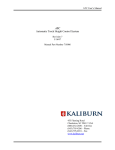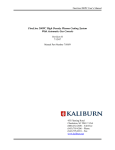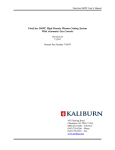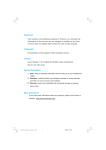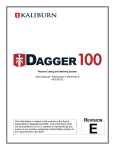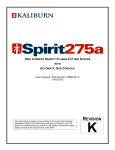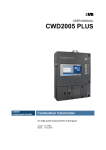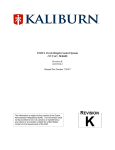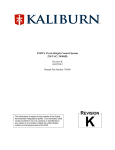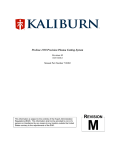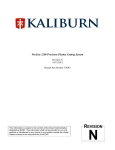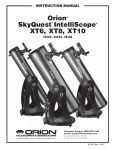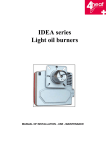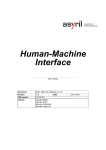Download Manual Cutting Mode
Transcript
SR-45i User’s Manual SR-45i Plasma Cutting System Revision 11 5/16/07 Manual Part Number 718061 455 Fleming Road Charleston, SC 29412 USA (800) 252-2850 – Toll free (843) 795-4286 – Phone (843) 795-8931 – Fax www.kaliburn.net This page intentionally left blank SR-45i User’s Manual Limited Warranty KALIBURN expressly warrants that this product shall be free from defects in materials and workmanship, under proper and normal use for the intended function of such equipment, for a period of one (1) year for the SR-45i torch and leads and three (3) years for the SR-45i power supply. This product is intended for commercial use and is not intended for personal, family, or household purposes. There are no warranties that extend beyond the description on the face hereof. All other warranties, either expressed or implied, including any implied warranty of merchantability or fitness for any particular purpose, are expressly excluded. If this product or any component thereof is determined to be defective in manufacture, KALIBURN will repair or replace the defective component or product. The buyer’s remedies are limited to the return of the product for repair or replacement of any non-conforming product or part at the sole discretion of KALIBURN. No freight charges of any kind are covered under this warranty. All returned goods shall be at the buyer’s risk and expense. Beyond this remedy, KALIBURN will not be responsible for any special, incidental or consequential damages or injury to the person or property of anyone by reason of any defect in any equipment sold hereunder. This warranty will be considered void if torches or torch consumables manufactured by anyone other than KALIBURN are incorporated into this product. Returned Goods Procedure KALIBURN utilizes a returned goods procedure that must be followed before returning any items for repair, replacement, or restocking. This means that a returned goods authorization number must be obtained prior to shipment to KALIBURN. It will be necessary for the customer to provide a description, along with the stock number and serial number, if applicable, of the item to be returned. In no case will KALIBURN accept a returned shipment without the proper returned goods authorization number. SR-45i User’s Manual Electromagnetic Compatibility (EMC) The 220/380V 50Hz and 415V 50Hz SR-45i plasma cutting systems are manufactured to comply with the European standards EN 60974 (Arc welding equipment – Part 1: Welding power sources) and EN 50199 (Electromagnetic compatibility (EMC) – Product standard for arc welding equipment). Information about the EMC standard EN 50199 can be found in Appendix A. SR-45i User’s Manual TABLE OF CONTENTS Section 1 Safety ..……………………………………..……………………………. 1-1 General Precautions .…………………………………………………..……….…..……… 1-1 Ultraviolet Radiation Protection ..…………………………………………………………. 1-1 Noise Protection .……………………………………………………..……………………. 1-1 Toxic Fume Prevention ...…………………………………………………………..……… 1-1 Electric Shock Prevention ...……………………………………………………….….…… 1-2 Fire Prevention ...…………………….………………………………….…………………. 1-3 Explosion Prevention .....…….….………….…………………………………..………….. 1-3 Health Support Equipment ...…………………….……………………………….………... 1-4 Safety Standards Booklet Index ...…………………….……………………………….…... 1-4 Section 2 Specifications ...….……...……………………………………………… 2-1 System Description ...……………………………………………………………………… 2-1 System Components ………………………………………………………………………. 2-1 Power Supply Specifications ……………………………………………………………… 2-1 Torch Specifications ...…………………………………………………………………….. 2-3 Airborne Noise Emissions ..……………………………………………………………….. 2-4 Operating Modes .........……………………………………………………………………..2-5 Section 3 Installation .....………………………………………………………… 3-1 Initial Inspection .......……………………………………………………………………… 3-1 Power Supply Installation .………………………………………………………………… 3-1 Primary Power Connection ...……………………………………………………………… 3-1 Power Supply Output Connections .......…………………………………………………… 3-3 Torch Connections ....……………………………………………………………………… 3-5 Gas Supply Connections ...............................……………………………………………… 3-6 CNC Machine Interface Connections ...…………………………………………………… 3-8 Section 4 Operation ……………………………………………………………… 4-1 Power Supply Front Panel Controls ..……………………………………………………… 4-1 Mechanized Cutting Mode ............………………………………………………………… 4-2 Manual Cutting Mode ...........................…………………………………………………… 4-3 Grate Cutting Mode ..............................…………………………………………………… 4-3 Insulation Cutting Mode ...………………………………………………………………… 4-3 Torch Consumables ......…………………………………………………………………… 4-4 Advanceable Electrode .…………………………………………………………………… 4-5 Setting up a Cut .........………………………………………………………………………4-6 Cut Quality ................……………………………………………………………………… 4-8 Cutting Chart .............……………………………………………………………………… 4-9 SR-45i User’s Manual Section 5 Maintenance and Troubleshooting ............................ 5-1 Daily Procedures ...................……........................................................................................ 5-1 Monthly Procedures .............................................................................................................. 5-2 220/230/240V 60 Hz Transformer Configurations ............................................................... 5-4 220/380V 50 Hz Transformer Configurations ...................................................................... 5-5 Logic-Regulator Status LED’s .............................................................................................. 5-7 Logic-Regulator Sequence of Operation .............................................................................. 5-7 General Troubleshooting ...................................................................................................... 5-8 Chopper Test Procedure ........................................................................................................ 5-11 Section 6 Parts List ........................................................................................... 6-1 Power Supply ........................................................................................................................ 6-1 Torch and Handle Assembly ................................................................................................. 6-9 Shielded Torch Leads ........................................................................................................... 6-10 Consumable Spare Parts Kit ................................................................................................. 6-11 Logic-Regulator P.C. Board ................................................................................................. 6-12 Chopper P.C. Board .............................................................................................................. 6-13 Appendix A Electromagnetic Compatibility (EMC) .......... A-1 Background ........................................................................................................................... A-1 Installation and Use ...............................................................................................................A-1 Assessment of Area ...............................................................................................................A-2 Methods of Reducing Emissions .......................................................................................... A-2 Primary Power Connection ................................................................................................... A-4 EMI Filter Parts List ............................................................................................................. A-5 Illustrations Figure 2-1 Figure 2-2 Figure 3-1 Figure 3-2 Figure 3-3 Figure 3-4 Figure 4-1 Figure 4-2 Figure 4-3 Figure 5-1 Figure 5-2 Figure 5-3 Figure 6-1 Figure 6-2 Figure 6-3 Figure 6-4 Power Supply Dimensions ............................................................................ 2-2 Torch Dimensions ......................................................................................... 2-3 Primary Power Connections ......................................................................... 3-2 Power Supply Output Connections ............................................................... 3-4 Torch Connections ........................................................................................ 3-5 Gas Supply Connections ............................................................................... 3-7 Front Panel Controls ..................................................................................... 4-2 Torch Consumables ...................................................................................... 4-4 Electrode Advancing Tool ............................................................................ 4-5 220/230/240V 60 Hz Three Phase Transformer ........................................... 5-4 220V 50 Hz Three Phase Transformer ......................................................... 5-6 380V 50 Hz Three Phase Transformer ......................................................... 5-6 Control Panel ................................................................................................ 6-3 Rear View - Inside ........................................................................................ 6-4 Base – Top View ........................................................................................... 6-5 Left Side View .............................................................................................. 6-6 SR-45i User’s Manual Figure 6-5 Figure 6-6 Figure 6-7 Figure 6-8 Figure 6-9 Figure 6-10 Figure A-1 Figure A-2 Right Side View ............................................................................................ 6-7 Rear View – Outside ..................................................................................... 6-8 Torch and Handle Assembly ......................................................................... 6-9 Shielded Torch Leads ................................................................................... 6-10 Logic-Regulator P.C. Board ......................................................................... 6-12 Chopper P.C. Board ...................................................................................... 6-13 Primary Power Connection ........................................................................... A-4 EMI Filter ......................................................................................................A-5 This page intentionally left blank Safety SR-45i User’s Manual Section 1 Safety General Precautions Whereas plasma cutting has been used safely for years, it does require certain precautions to ensure the safety of the operator and other people around the equipment. It is management’s responsibility to see that the following safety information is provided to each person who will operate, observe, perform maintenance, or work in close proximity to this piece of equipment. Installation, as well as repairs, made to the SR-45i system should only be performed by qualified personnel. The SR-45i system makes use of both A.C. and D.C. circuitry for operation. Fatal shock hazard does exist. Exercise extreme caution while working on the system. Ultraviolet Radiation Protection Plasma cutting produces ultraviolet radiation similar to a welding arc. This ultraviolet radiation can cause skin and eye burns. For this reason, it is essential that proper protection be worn. The eyes are best protected by using safety glasses or a welding helmet with an AWS No. 8 shade or ISO 4850 No. 11 shade, which provides protection up to 100 amperes. All exposed skin areas should be covered with flame-retardant clothing. The cutting area should also be prepared in such a way that ultraviolet light does not reflect. Walls and other surfaces should be painted with dark colors to reduce reflected light. Protective screens or curtains should be installed to protect additional workers in the area from ultraviolet radiation. Noise Protection The SR-45i system generates high noise levels while cutting. Depending on the size of the cutting area, distance from the cutting torch, and arc current cutting level, acceptable noise levels may be exceeded. Proper ear protection should be used as defined by local or national codes. See Section 2 for noise emission levels. Toxic Fume Prevention Care should be taken to ensure adequate ventilation in the cutting area. Some materials give off toxic fumes that can be harmful or fatal to people in the vicinity of the cutting area. Also, some solvents decompose and form harmful gases when exposed to ultraviolet radiation. These solvents should be removed from the area prior to cutting. 1-1 Safety SR-45i User’s Manual Galvanized metal can produce harmful gases during the cutting process. Ensure proper ventilation and use breathing equipment when cutting these materials. Certain metals coated with or containing lead, cadmium, zinc, beryllium, and mercury produce harmful toxins. Do not cut these metals unless all people subjected to the fumes wear proper air breathing equipment. Electric Shock Prevention The SR-45i system uses high open circuit voltages that can be fatal. Extreme care should be used when operating or performing maintenance on the system. Only qualified personnel should service the SR-45i system. Observe the following guidelines to protect against electric shock: • • • • • • • • • • • • A wall-mounted disconnect should be installed and fused according to local and national electrical codes. The disconnect should be located as close as possible to the power supply so it can be turned off in case of an emergency. The primary power cord should have a 600 volt minimum rating in order to protect the operator. In addition, it should be sized according to local and national electrical codes. Inspect the primary power cord frequently. Never operate the SR-45i system if the power cord is damaged in any way. Make sure the primary power ground wire is connected to the input power ground stud on the SR-45i power supply. Make sure the connection is securely tightened. Make sure the positive output (work ground) of the SR-45i power supply is connected to a bare metal area on the cutting table. A driven ground rod should be placed no further than five feet from this connection. Make sure this ground point on the cutting table is used as the star ground point for all other ground connections. Inspect the torch leads frequently. Never use the system if the leads are damaged in any way. Do not stand in wet, damp areas when operating or performing maintenance on the system. Wear insulated gloves and shoes while operating or performing maintenance on the system. Make sure the SR-45i system is switched off at the wall disconnect before servicing the power supply or torch. Never change torch consumable parts unless the SR-45i system is switched off at the wall disconnect. Do not attempt to remove any parts from beneath the torch when cutting. Remember that the workpiece forms the current path back to the power supply. Never bypass the safety interlock devices. Before removing any of the SR-45i covers, switch the system off at the wall disconnect. Wait at least five (5) minutes before removing any cover. This 1-2 Safety SR-45i User’s Manual • • Never operate the SR-45i system without all of the covers in place. Preventive maintenance should be performed daily to avoid possible safety hazards. Fire Prevention When using the SR-45i system, it is necessary to exercise good judgment. While cutting, the arc produces sparks that could cause a fire should they fall on flammable material. Make sure that all flammable material, such as paper, cloth, etc., is a suitable distance away from the cutting area. All flammable liquids should be at least 40 feet away from the cutting area, preferably stored in a metal cabinet. Plasma cutting should never be attempted on containers that contain flammable materials. Make sure that fire extinguishers are readily accessible in the cutting area. Explosion Prevention The SR-45i system uses compressed gases. Use proper techniques when handling compressed gas cylinders and other compressed gas equipment. Observe the following guidelines to protect against explosion: • • • • • • • • • • • Never operate the SR-45i system in the presence of explosive gases or other explosive materials. Never cut pressurized cylinders or any closed container. When using a water table and cutting aluminum under water or with water touching the underside of the aluminum plate, hydrogen gas is produced. This hydrogen gas may collect under the plate and explode during the cutting process. Make sure the water table is properly aerated to help prevent the accumulation of hydrogen gas. Handle all gas cylinders in accordance with safety standards published by the U.S. Compressed Gas Association (CGA), American Welding Society (AWS), Canadian Standards Association (CSA), or other local or national codes. Compressed gas cylinders should be maintained properly. Never attempt to use a cylinder that is leaking, cracked, or has other signs of physical damage. All gas cylinders should be secured to a wall or rack to prevent accidental knock over. If a compressed gas cylinder is not being used, replace the protective valve cover. Never attempt to repair compressed gas cylinders. Keep compressed gas cylinders away from intense heat, sparks, or flames. Clear the compressed gas cylinder connection point by opening the valve momentarily prior to installing a regulator. Never lubricate compressed gas cylinder valves or pressure regulators with 1-3 Safety SR-45i User’s Manual • • • • • any type of oil or grease. Never use a compressed gas cylinder or pressure regulator for any purpose other than which it is intended. Never use a pressure regulator for any gas other than which it is intended. Never use a pressure regulator that is leaking or has other signs of physical damage. Never use oxygen hoses and pressure regulators for any gas other than oxygen. Never use any gas hose that is leaking or has other signs of physical damage. Health Support Equipment The SR-45i system creates electric and magnetic fields that may interfere with certain types of health support equipment, such as pacemakers. Any person who uses a pacemaker or similar item should consult a doctor before operating, observing, maintaining, or servicing the SR-45i system. Observe the following guidelines to minimize exposure to these electric and magnetic fields: • • • • Stay as far away from the SR-45i power supply, torch, torch leads, and remote high frequency console as possible. Route the torch leads as close as possible to the work ground cable. Never place your body between the torch leads and work ground cable. Keep the work ground cable and the torch leads on the same side of your body. Never stand in the center of a coiled up set of torch leads or work ground cable. Safety Standards Booklet Index For further information concerning safety practices to be exercised with plasma arc cutting equipment, please refer to the following publications: 1. AWS Standard AWN, Arc Welding and Cutting Noise, obtainable from the American Welding Society, 550 NW LeJeune Road, Miami, FL 33126. 2. AWS Standard C5.2, Recommended Practices for Plasma Arc Cutting, obtainable from the American Welding Society, 550 NW LeJeune Road, Miami, FL 33126. 3. AWS Standard FSW, Fire Safety in Welding and Cutting, obtainable from the American Welding Society, 550 NW LeJeune Road, Miami, FL 33126. 4. AWS Standard F4.1, Recommended Safe Practices for Preparation for Welding and Cutting of Containers and Piping, obtainable from the American Welding Society, 550 NW LeJeune Road, Miami, FL 33126. 1-4 Safety SR-45i User’s Manual 5. AWS Standard ULR, Ultraviolet Reflectance of Paint, obtainable from the American Welding Society, 550 NW LeJeune Road, Miami, FL 33126. 6. AWS / ANSI Standard Z49.1, Safety in Welding, Cutting, and Allied Processes, obtainable from the American Welding Society, 550 NW LeJeune Road, Miami, FL 33126. 7. ANSI Standard Z41.1, Standard For Men’s Safety-Toe Footwear, obtainable from the American National Standards Institute, 11 West 42nd Street, New York, NY 10036. 8. ANSI Standard Z49.2, Fire Prevention in the Use of Cutting and Welding Processes, obtainable from the American National Standards Institute, 11 West 42nd Street, New York, NY 10036. 9. ANSI Standard Z87.1, Safe Practices For Occupation and Educational Eye and Face Protection, obtainable from the American National Standards Institute, 11 West 42nd Street, New York, NY 10036. 10. ANSI Standard Z88.2, Respiratory Protection, obtainable from the American National Standards Institute, 11 West 42nd Street, New York, NY 10036. 11. OSHA Standard 29CFR 1910.252, Safety and Health Standards, obtainable from the U.S. Government Printing Office, Washington, D.C. 20402. 12. NFPA Standard 51, Oxygen - Fuel Gas Systems for Welding, Cutting, and Allied Processes, obtainable from the National Fire Protection Association, 1 Batterymarch Park, Quincy, MA 02269. 13. NFPA Standard 51B, Cutting and Welding Processes, obtainable from the National Fire Protection Association, 1 Batterymarch Park, Quincy, MA 02269. 14. NFPA Standard 70, National Electrical Code, obtainable from the National Fire Protection Association, 1 Batterymarch Park, Quincy, MA 02269. 15. CGA booklet P-1, Safe Handling of Compressed Gases in Containers, obtainable from the Compressed Gas Association, 1725 Jefferson Davis Highway, Suite 1004, Arlington, VA 22202. 16. CGA booklet P-14, Accident Prevention in Oxygen-Rich and OxygenDeficient Atmospheres, obtainable from the Compressed Gas Association, 1725 Jefferson Davis Highway, Suite 1004, Arlington, VA 22202. 1-5 Safety SR-45i User’s Manual 17. CGA booklet TB-3, Hose Line Flashback Arrestors, obtainable from the Compressed Gas Association, 1725 Jefferson Davis Highway, Suite 1004, Arlington, VA 22202. 18. CSA Standard W117.2, Safety in Welding, Cutting, and Allied Processes, obtainable from Canadian Standards Association, 178 Rexdale Boulevard, Toronto, Ontario M9W lR3, Canada. 19. Canadian Electrical Code Part 1, Safety Standard for Electrical Installations, obtainable from the Canadian Standards Association, 178 Rexdale Boulevard, Toronto, Ontario M9W 1R3, Canada. 1-6 Specifications SR-45i User’s Manual Section 2 Specifications System Description The SR-45i is a versatile, 45 amp, 100% duty cycle conventional air plasma cutting system that provides continuous operation, patented long life electrodes, and a true constant current output from 20 to 45 amperes. It utilizes a single gas torch that is capable of cutting gauge to 1/2” thick material. The SR-45i also has 4 modes of operation, which provide the capability for cutting all types of material, including expanded metal and insulation. These features alone provide durability, cost effective operation and excellent cut quality. In addition, the use of air as the plasma and cooling gas enhances the cost effectiveness. System Components The SR-45i consists of the following components: • • • • • • • Power Supply Torch and Handle Assembly Torch Lead Set Work Ground Lead Air regulator / Filter System Manual Consumable Spare Parts Kit Power Supply Specifications Stock Number: 200/220 VAC, 1Ø, 50Hz ..................................... 745002 208 VAC, 1Ø, 60Hz ............................................. 745000 220 VAC, 1Ø, 60Hz ............................................. 745001 208 - 480 VAC, 3Ø, 60Hz .................................... 745018 220/380 VAC, 3Ø, 50Hz ...................................... 745003 415 VAC, 3Ø, 50Hz ............................................. 745004 575 VAC, 3Ø, 60Hz ............................................. 745006 Input Current at Maximum Output: 200 VAC, 1Ø ....................................................... 38 amps 208 VAC, 1Ø ....................................................... 37 amps 208 VAC, 3Ø ....................................................... 23 amps 220 VAC, 1Ø ....................................................... 35 amps 220 VAC, 3Ø ....................................................... 22 amps 2-1 Specifications SR-45i User’s Manual 240 VAC, 3Ø ....................................................... 20 amps 380 VAC, 3Ø ....................................................... 11 amps 415 VAC, 3Ø ....................................................... 10 amps 460 VAC, 3Ø ....................................................... 9 amps 575 VAC, 3Ø ....................................................... 7 amps Open Circuit Voltage ................................................ 230 VDC Output Current .......................................................... 20-45 amps Maximum Output Voltage ........................................ 175 VDC Duty Cycle ................................................................ 100% Maximum Ambient Temperature ............................. 104° F (40° C) Dimensions: Width ................................................................... 19 in (483 mm) Height ................................................................... 32.5 in (826 mm) Depth .................................................................... 20 in (508 mm) Weight: Single Phase ......................................................... 245 lb (111 kg) Three Phase .......................................................... 265 lb (120 kg) Gas Supply Requirements: Quality .................................................................. Clean, dry, oil-free air Flow Rate ............................................................. 250 scfh (7075 liters/hour) Inlet Pressure ........................................................ 65 psi (4.5 bar) OFF ON A.C. POWER D.C. POWER GAS SET AMPS 25 30 MOTION DELAY 35 40 RUN −4 SR 20 45 MIN MAX 5i Figure 2-1 Power Supply Dimensions 2-2 Specifications SR-45i User’s Manual Torch Specifications Stock Number: Torch main body .................................................. 770073 Torch handle assembly ........................................ 770075 Diameter ....................................................................1.375 in (35 mm) Length: Torch main body .................................................. 3.5 in (118 mm) Torch main body / handle assembly .................... 12.8 in (325 mm) Weight (including handle) ........................................ 1.33 lb (.6 kg) Figure 2-2 Torch Dimensions 2-3 Specifications SR-45i User’s Manual Airborne Noise Emissions The SR-45i system generates high noise levels while cutting. Depending on the size of the cutting area, distance from the cutting torch, and arc current cutting level, acceptable noise levels may be exceeded. Proper ear protection should be used as defined by local or national codes. The following chart gives the noise levels generated by the SR-45i when operating at 45 amps, 115 arc volts. The measurements were made with a sound level meter. Distance From Torch A-Weighted Sound Pressure Level C-Weighted Sound Pressure Level 1 meter horizontal / 1.6 meters above the workpiece 91 dB 88 dB The maximum noise level is 117 dB at a distance of 2 inches (50.8 mm) from the torch while cutting at 45 amps, 115 arc volts. 2-4 Specifications SR-45i User’s Manual Operating Modes The operating mode of the SR-45i is switch selectable and can either be mechanized, manual, grate, or insulation. The mode switch is located on the left side of the power supply. The operating modes are described below. Mechanized Cutting Mode: After receiving a plasma start signal, the power supply goes through a gas preflow sequence, initiates a pilot arc, and then transfers the arc to the workpiece. The transferred arc sensor provides an x/y machine motion enable signal, which can be delayed to allow for piercing time. Loss of the cutting arc disables the motion signal and deenergizes the SR-45i system, even if the plasma start signal remains enabled. Manual Cutting Mode: The starting sequence is the same as that in the mechanized cutting mode. However, if the plasma start signal remains enabled, automatic restart of the arc is initiated upon loss of the cutting arc. The motion signal will remain enabled during the restart and is disabled only when the plasma start signal is removed. Grate Cutting Mode: The starting sequence is the same as that in the mechanized cutting mode. However, the pilot arc relay remains closed, so no restarting of the arc is required between spaces in the metal. The motion signal remains enabled in spaces between the metal, and is disabled only when the plasma start signal is removed. Insulation Cutting Mode: The insulation cutting mode utilizes the pilot arc for cutting insulating type material. In this mode, the x/y machine motion signal is enabled after the pilot arc is established. As in the other modes, the motion enable signal can be delayed using the motion delay potentiometer. The cutting current is automatically set on the logic-regulator circuit board, and any front panel current setting is ignored. 2-5 This page intentionally left blank Installation SR-45i User’s Manual Section 3 Installation Initial Inspection All systems undergo full testing before being shipped from KALIBURN. In the unlikely event that one of your components is defective or missing, please contact KALIBURN so a replacement item can be sent to you. Also, KALIBURN has taken special care in packaging your SR-45i system. If your system was damaged during shipment, you will have to file a claim with the shipping company. Next, it will be necessary to contact KALIBURN so replacement parts can be ordered. If you need additional assistance, please contact KALIBURN. Power Supply Installation The SR-45i power supply should be lifted by a forklift or pallet jack only. In order to prevent damaging the power supply, the forks should be of adequate length to protrude on the far side of the power supply. The proper location of the power supply will provide dependable service and reduce periodic maintenance time. Choose a location that will provide unrestricted air movement into and out of the power supply. Maintain at least 24 inches of space on all sides of the unit. The location should subject the power supply to the least amount of dust, dirt, moisture, and corrosive vapors. The power supply must be cleaned as often as necessary to prevent the accumulation of metallic dust inside the unit. See Figure 2-1 for power supply dimensions. Primary Power Connection ** Before connecting primary power, check the data plate to verify the voltage required by the SR-45i power supply ** Note: See Appendix A for additional information on 220/380V and 415V 50Hz systems. A primary disconnect switch should be provided for each SR-45i power supply. The disconnect switch should be located as close as possible to the power supply so it can be turned off quickly in case of an emergency. The disconnect switch should be equipped with time delay fuses only. The magnetic inrush current of the power supply will cause fast acting fuses to blow. The disconnect switch should be sized according to local and national codes. The rating must meet or exceed the continuous rating of the fuses used. See the following chart for recommended fuse sizes: 3-1 Installation SR-45i User’s Manual Input Voltage (VAC) Phase 200 208 220 208 220 240 380 415 460 575 1 1 1 3 3 3 3 3 3 3 Input Current at Maximum Output (amps) 38 37 35 23 22 20 11 10 9 7 Recommended Time-Delay Fuse Size (amps) 50 50 45 30 30 25 15 12 12 9 Use a Type SO power cable to connect the primary power to the SR-45i power supply. The power cable should have a 600 volt minimum rating and should be sized according to local and national codes. Route the power cable through the strain relief on the rear of the power supply and connect the hot lines to the input terminals on the safety contactor CON1 as shown in Figure 3-1. Note that the center terminal of CON1 is not used in single phase systems. Be sure to connect the primary ground cable to the ground stud on the sub-panel. Main Contactor (CON2) Sub-Panel Ground Stud Safety Contactor (CON1) Type SO Power Cable Figure 3-1 Primary Power Connections 3-2 Disconnect Box Connections L1 (U) L2 (V) L3 (W) Ground Installation SR-45i User’s Manual Power Supply Output Connections Perform the following steps to connect the output of the power supply to the torch leads and the work table. See Figure 3-2 for additional information. Note: When making hose connections, only tighten the brass fittings enough to make a gas seal. The fittings are subject to damage if over tightened. Torch Leads 1 1. Remove the threaded ring from the brass shield connector on the end of the braided shield. 2. Route the torch leads through the opening in the rear of the power supply and push the shield connector through the hole until it is seated against the sheet metal. 3. Slide the threaded ring over the torch leads and thread onto the shield connector. Tighten the threaded ring firmly. The shield connector grounds the braided shield to the power supply enclosure to help eliminate high frequency noise emission. Using an ohmmeter, measure zero ohms between the braided shield and the ground stud on the sub-panel inside the power supply. 4. Connect the cathode torch lead (1/4” hose) to the Torch Minus fitting on the I/O board. The cathode lead has a right-handed nut. 5. Connect the pilot arc lead (3/16” hose) to the Pilot Arc fitting on the I/O board. The pilot arc lead has a right-handed nut. Work Ground Lead 2 1. Route one end of the #6 AWG work ground lead through the bushing on the lower rear of the power supply and connect it to the Work Ground connection on the I/O board. 2. Connect the other end of the work ground lead to the star ground point on the cutting table. The star ground point is generally referred to as the common ground point on the cutting table where all subsystems of the machine are grounded. This point is then connected to a driven earth ground rod that should be as close as possible to the star ground. The ground rod should have no other wires connected to it. The ground rod should be at least 3/4 inches in diameter and should be driven into the earth’s permanent moisture layer. The length of the ground rod varies from installation to installation and should be installed according to local and national codes. Refer to the National Electrical Code, Article 250, Section H, Ground Electrode System for additional information. 3-3 Installation SR-45i User’s Manual Tighten Securely SR−45i Figure 3-2 Power Supply Output Connections 3-4 Installation SR-45i User’s Manual Torch Connections Perform the following steps to connect the torch leads to the torch. Note: When making hose connections, only tighten the brass fittings enough to make a gas seal. The fittings are subject to damage if over tightened. Also, use two wrenches when tightening the torch fittings to avoid damaging the torch 1. Unscrew the torch handle assembly from the torch main body and slide the torch leads through the handle. 2. Attach the cathode torch lead (1/4” hose) to the cathode fitting on the torch body. The cathode lead has a right-handed nut. 3. Attach the pilot arc torch lead (3/16” hose) to the pilot arc fitting on the torch body. The pilot arc fitting has a left-handed nut and is identified by a machined line on the nut itself. 4. Slide the torch handle down over the connections and thread the handle onto the torch body, being careful to avoid cross-threading the handle. When tightening the handle, be sure to turn the handle and not the torch body. This will avoid twisting the torch leads. Torch Cathode Lead Pilot Arc Lead Torch Handle Figure 3-3 Torch Connections 3-5 Installation SR-45i User’s Manual Gas Supply Connections The SR-45i requires clean, dry, oil-free compressed air for good cut quality, as well as long consumable life. The SR-45i plasma system is supplied with a regulator-filter to filter the incoming gas supply. Additional filtration may be required if there is moisture, oil, or other contaminants in the gas supply. The regulator-filter supplied with the SR-45i should be used with industrial compressed air systems only. It must not be used where the inlet pressure can exceed 150 psi or when the temperature can exceed 125NF. The SR-45i is shipped without the regulator-filter installed to avoid shipping damage. The regulator should be mounted in the vertical position on the rear panel to allow filtered material to drain through the lower exit tube. Some units are equipped with an automatic drain and others have a manual drain. In either case, be sure that contaminants do not accumulate in the filter bowl. The filter element will require periodic replacement, depending on the amount of contamination in the line. Replacement filter elements are available from KALIBURN. Looking at the rear of the power supply, connect the gas supply to the right port of the regulator. A 1/4" (6 mm) inside diameter minimum hose size should be used. Using the hose provided, connect the left port of the regulator to the inlet port on the lower left of the power supply. See Figure 3-4 for more information. Be sure that all gas supply connections are tight. Leaks in the supply can cause poor cut quality. 3-6 Installation SR-45i User’s Manual Adjust regulator to 65 psi with gas switch in the set position Connect gas supply to this port using 1/4" (6 mm) I.D. minimum hose size SR−45i Figure 3-4 Gas Supply Connections 3-7 Installation SR-45i User’s Manual CNC Machine Interface Connections Perform the following steps to properly interface the SR-45i system with a CNC cutting machine. See the system schematic for additional information. Plasma Start Signal • The SR-45i requires a contact closure between P8 pins 3 and 4 to commence the cutting sequence. The cutting sequence is terminated when the contacts are opened. The contacts should be rated for 24VAC - 10mA. Motion Output Signal • The SR-45i provides a maintained contact closure or 24VAC output between P8 pins 12 and 14 as long as a cutting arc is maintained between the torch and the workpiece. To configure the motion signal for a contact closure, connect a jumper wire between terminal block TB1 positions 11 and 13. To configure the motion signal for 24VAC, connect a jumper wire between terminal block TB1 positions 10 and 11 and another jumper wire between terminal block TB1 positions 12 and 13. TB1 is located on the sub-panel of the system behind the rear panel. The motion contacts are rated for 10A - 250VAC or 10A – 30VDC. 3-8 Operation SR-45i User’s Manual Section 4 Operation Power Supply Front Panel Controls The SR-45i controls and status indicator lights are located on the front panel of the system, with the exception of the mode switch which is located on the left side of the power supply. This section describes the function of each control and indicator. See Figure 4-1 for front panel control and indicator locations. Power Off Button 1 Deenergizes the SR-45i system and turns off the cooling fans. Power On Button/Indicator 2 Energizes the SR-45i system and turns on the cooling fans. Illuminates to show that the system is energized. AC Power Indicator 3 Illuminates when primary power is applied to the SR-45i system. DC Power Indicator 4 Illuminates when then main contactor has been energized and D.C. current is flowing through the torch. Gas Switch 5 In the Set mode, energizes the gas solenoid so the gas pressure may be adjusted. In the Run mode, the gas solenoid is deenergized. Current Adjust Potentiometer 6 Used to set the output current of the SR-45i. Motion Delay Potentiometer 7 Used to delay the x/y machine motion when piercing thicker materials. The delay can be adjusted from 0 to 3 seconds. Digital Mode Switch Thumbwheel 8 The Mode Switch is located on the left side of the SR-45i and is used to set the operating mode of the system. 4-1 Operation SR-45i User’s Manual Figure 4-1 Front Panel Controls Mechanized Cutting Mode To place the SR-45i in the mechanized cutting mode, set the Mode Switch thumbwheel to position number 2. The start signal initiates the following sequence of events: 1. 2. 3. 4. Two-second gas preflow. Pilot arc initiation. Transferred arc establishes (cutting arc). X/Y machine motion signal enabled. Note that the machine motion signal can be delayed for up to three seconds using the motion delay potentiometer on the front panel. Removal of the plasma start signal terminates cutting, disables the x/y machine motion signal, and initiates gas postflow. Note: Loss of the cutting arc, even if a plasma start signal is applied, deenergizes the SR-45i system, disables the x/y machine motion signal, and initiates postflow of gas. Reapplying the plasma start signal while in the gas postflow stage will initiate the cutting arc immediately, without going through the gas preflow sequence. 4-2 Operation SR-45i User’s Manual Manual Cutting Mode To place the SR-45i in the manual cutting mode, set the Mode Switch thumbwheel to position number 0. The manual cutting mode is used when it is necessary to automatically reestablish a lost cutting arc. For example, if the torch is going to cross a pre-cut kerf during a cutting sequence, the arc may be lost. In mode 0, the pilot arc relay will automatically close and the arc will be reignited. The sequence for initiating the arc is the same as in the mechanized cutting mode. However, when the cutting arc is lost, the pilot arc is reestablished with continuous high frequency and will remain in the pilot arc high frequency state until a cutting arc is reestablished. The x/y machine motion signal will remain enabled during restarting of the cutting arc. The cutting sequence is terminated when the plasma start signal is disabled. Grate Cutting Mode To place the SR-45i in the grate cutting mode, set the Mode Switch thumbwheel to position number 5. The grate cutting mode is used for cutting expanded metal or grate material. The starting sequence is the same as that for mechanized cutting. However, the pilot arc relay remains closed during the cut. As a result, the torch reverts to a pilot arc condition when the transferred arc is lost in spaces between the metal. The x/y machine motion signal remains enabled until the plasma start signal is removed. High frequency starting is only required for the initial cutting arc, but will reignite the arc if it is lost for some reason. The cutting sequence is terminated when the plasma start signal is disabled. Insulation Cutting Mode To place the SR-45i in the insulation cutting mode, set the Mode Switch thumbwheel to position number 9. The insulation cutting mode provides a continuous pilot arc for cutting nonmetallic substances. The cutting current is automatically set on the logic-regulator p.c. board, and any front panel current setting is ignored. When the pilot arc is established, the x/y machine motion signal is enabled, even there is no transferred arc. As in the other modes, the x/y machine motion signal can be delayed for up to three seconds after arc initiation by adjusting the motion delay potentiometer on the front panel. The cut is terminated when the plasma start signal is removed. 4-3 Operation SR-45i User’s Manual Torch Consumables Figure 4-2 shows the different torch consumable configurations for cutting various materials with the SR-45i. TORCH CONSUMABLES WHEN CUTTING MATERIALS GREATER THAN 1/8" (3 mm) THICK RETAINING CAP 770098 FLAT NOZZLE 770000 SWIRL RING 770012 ELECTRODE 770015 or 770017 TORCH BODY 770073 TORCH CONSUMABLES WHEN CUTTING MATERIALS UP TO 1/8" (3 mm) THICK RETAINING CAP 770098 TAPERED NOZZLE 770104 SWIRL RING 770012 ELECTRODE 770015 or 770017 TORCH BODY 770073 TORCH CONSUMABLES WHEN CUTTING INSULATING MATERIAL RETAINING CAP 770098 INSULATION NOZZLE SWIRL RING 770030 770012 ELECTRODE 770015 or 770017 Figure 4-2 Torch Consumables 4-4 TORCH BODY 770073 Operation SR-45i User’s Manual Advanceable Electrode The SR-45i torch uses a patented advanceable electrode PN 770015. This means on an average, an electrode can be used four different times. The length of time a particular electrode can be used is determined by the depth of the crater that is formed in the electrode material. Typically, the electrode should be advanced after an hour of use, which will eliminate the copper electrode casing from being eroded. Using the electrode advancing tool provided in the spare parts kit, the electrode should be pushed out of the copper casing a distance equal to the depth of the crater. Then, while still in the electrode tool, the cratered electrode material should be ground away until it is flush with the original copper casing. This can be accomplished by using a common bench grinder. Care should be taken so that none of the copper material is removed in the grinding process. Note that a non-advanceable electrode PN 770017 is available. Figure 4-3 Electrode Advancing Tool 4-5 Operation SR-45i User’s Manual Setting up a Cut Use the following procedure to make a cut with the SR-45i. 1. Using the charts in this section, determine the proper torch parts and cutting conditions for the material being cut. 2. Apply a small amount of o-ring lubricant PN 716008 to the o-ring PN 770072 on the torch body. O-RING 770072 3. Place the advanceable electrode PN 770015 or non-advanceable electrode PN 770017 into the swirl ring PN 770012 by inserting the small end of the electrode into the large opening of the swirl ring. The large diameter of the electrode should bottom-out and fit snugly into the swirl ring. 4. Place the appropriate nozzle onto the small end of the swirl ring. Use the tapered metal cutting nozzle PN 770104 for cutting gauge material through 1/8”, or use the flat metal cutting nozzle PN 770000 for cutting material over 1/8” thick. Use the insulation cutting nozzle PN 770030 for cutting insulating material. Note that the insulation cutting nozzle has a groove machined in the side so it can be distinguished from the flat metal cutting nozzle. METAL CUTTING NOZZLE 770000 INSULATION CUTTING NOZZLE 770030 NOTE GROOVE LOCATION 5. Place the electrode/swirl ring/nozzle assembly into the retaining cap PN 770098 and make sure the nozzle flange is seated in the retaining cap recess. 6. Thread the retaining cap onto the torch and hand tighten FIRMLY. It is very important that all parts are seated tightly to prevent the torch from arcing internally. 4-6 Operation SR-45i User’s Manual 7. Apply primary power to the SR-45i. The A.C. Power light on the front panel should illuminate, indicating that primary power has been applied; however, never assume the power is disconnected when the white light is out. 8. Depress the green On button to energize the power supply. 9. Place the Gas switch in the set position and adjust the regulator pressure to 65 psi while gas is flowing through the torch. Return the Gas switch to the Run position. 10. Set the Motion Delay potentiometer to minimum for material thicknesses up to 1/8”. Thicker materials will require longer motion delays to allow the arc to fully penetrate the material. 11. Set the Current potentiometer according to the cutting chart in this section. 12. Set the Mode Switch to the proper mode, as previously described. 13. The cutting operation is initiated after a start signal is received. The arc should establish after approximately 2 seconds of gas preflow. Throughout the cut, the red D.C. Power light on the front panel should be illuminated to indicate that current is flowing through the torch. The cutting operation is terminated when the start signal is removed. At the completion of a cut, gas should flow through the torch for approximately 10 seconds. 4-7 Operation SR-45i User’s Manual Cut Quality Before the optimum cutting condition can be achieved on a particular material type and thickness, the machine operator must have a thorough understanding of the cutting characteristics of the SR-45i system. When the cut quality is not satisfactory, the cutting current, speed, or torch height may need to be adjusted until the proper cutting condition is obtained. The following guidelines should be useful in determining which cutting parameter to adjust. Note: Before making any parameter changes, verify that the torch is square to the workpiece. Also, it is essential to have the correct torch parts in place and to ensure that they are in good condition. Check the electrode for excessive wear and the nozzle orifice for roundness. Also, make sure that the air pressure is adjusted to 65 psi with the Gas switch in the Set position and that the air supply is not contaminated. 1. A positive cut angle (top dimension of piece smaller than the bottom dimension) usually occurs when the torch standoff distance is too high, when cutting too fast, or when excessive power is used to cut a given plate thickness. 2. A negative cut angle (top dimension of piece larger than the bottom dimension) usually occurs when the torch standoff distance is too low or when the cutting speed is too slow. 3. Top dross usually occurs when the torch standoff distance is too high. 4. Bottom dross usually occurs when the cutting speed is either too slow (slowspeed dross) or too fast (high-speed dross). Low-speed dross is easily removed, while high-speed dross usually requires grinding or chipping off. 5. Note that different material compositions have an effect on dross formation. 4-8 Operation SR-45i User’s Manual Cutting Chart The following conditions are intended to give the operator the best starting point to use when making a cut on a particular material type and thickness and may not reflect optimum conditions. Different metal compositions, consumable parts wear, and air quality will affect the cutting speeds and torch height. Material Type Material Thickness Arc Torch Height Travel Speed Grate Cutting Current Travel Speed (inches/GA) (mm) (amps) (inches) (mm) (ipm) (mm/min) (ipm) (mm/min) Galvanized Galvanized Galvanized Galvanized Galvanized Galvanized Galvanized .019 / 28 .022 / 26 .028 / 24 .034 / 22 .040 / 20 .052 / 18 .063 / 16 .5 .6 .7 .9 1.0 1.3 1.6 35 35 35 40 45 45 45 1/16 1/16 1/16 1/16 1/16 1/16 1/16 1.5 1.5 1.5 1.5 1.5 1.5 1.5 450 400 325 300 285 220 200 11,430 10,160 8,255 7,620 7,240 5,590 5,080 235 210 170 155 150 115 105 5,970 5,335 4,320 3,935 3,810 2,920 2,665 Mild Steel Mild Steel Mild Steel Mild Steel Mild Steel 1/16 1/8 1/4 3/8 1/2 1.6 3.2 6.4 9.5 12.7 45 45 45 45 45 1/16 1/16 .075 .075 .075 1.5 1.5 2.0 2.0 2.0 275 130 45 25 15 6,985 3,300 1,145 635 380 135 65 3,430 1,650 .015 / 28 .018 / 26 .024 / 24 .030 / 22 .036 / 20 .048 / 18 1/16 1/8 1/4 3/8 1/2 .4 .5 .6 .8 .9 1.2 1.6 3.2 6.4 9.5 12.7 35 35 35 35 35 45 45 45 45 45 45 1/16 1/16 1/16 1/16 1/16 1/16 1/16 1/16 .075 .075 .075 1.5 1.5 1.5 1.5 1.5 1.5 1.5 1.5 2.0 2.0 2.0 425 400 375 350 325 300 250 110 35 20 10 10,795 10,160 9,525 8,890 8,255 7,620 6,350 2,795 890 510 255 220 210 195 180 170 155 125 55 5,590 5,335 4,955 4,570 4,320 3,935 3,175 1,395 1/32 1/16 3/32 1/8 1/4 .8 1.6 2.4 3.2 6.4 35 35 45 45 45 .075 .075 .075 .125 .125 2.0 2.0 2.0 3.2 3.2 350 250 150 100 30 8,890 6,350 3,810 2,540 760 180 130 75 50 4,570 3,300 1,905 1,270 Stainless Stainless Stainless Stainless Stainless Stainless Stainless Stainless Stainless Stainless Stainless Aluminum Aluminum Aluminum Aluminum Aluminum 1 inch = 25.4 mm; 1 psi = .0689 bar = 6.895 KPa With the Gas switch in the Set position, adjust the regulator on the rear panel to 65 psi. 4-9 This page intentionally left blank Maintenance and Troubleshooting SR-45i User’s Manual Section 5 Maintenance and Troubleshooting Warning: Only qualified maintenance personnel should perform maintenance on the SR-45i system. The system utilizes potentially fatal A.C. and D.C. voltages. All maintenance should be performed with safety in mind. Be aware that the large blue electrolytic capacitors inside the power supply store large amounts of energy even after power has been removed from the system. Wait at least five minutes after turning off power before touching any of the internal components. Daily Procedures SR-45i Power Supply 1. Verify that the white A.C. Power light is illuminated whenever primary A.C. power is applied to the system. 2. Depress the green On push button and verify that the fan motor is on. 3. Place the Gas switch in the Set position and verify that air is flowing through the torch. 4. With the Gas switch in the Set position, adjust the regulator on the rear panel of the SR-45i to 65 psi. Return the Gas switch to the Run position. 5. Raise the torch 2 inches above the workpiece. Apply a start signal to the SR45i using the CNC control. The pilot arc should be established in approximately 2 seconds. The arc should extend approximately 1 inch from the nozzle and should make a smooth swishing sound. If a popping or “motorboat” sound occurs, there may be a problem that needs correction. ** WARNING ** Remove primary power from the system before performing the following procedures SR-45i Torch Leads 1. Check the braided shield for nicks or cuts. If the braided shield is damaged, make sure the hoses are in good working condition. If there are any holes in the hoses, the torch leads must be replaced. SR-45i Torch 1. Remove all consumables from the torch and verify that the anode-cathode insulator (brown plastic) is in good condition and has no signs of arcing. 2. Check all consumables and discard any damaged items. 3. Verify that the electrode seat is clean to insure proper electrical contact. 4. Check the o-ring on the torch for signs of damage. Apply a thin film of o-ring lubricant to the o-ring. 5-1 Maintenance and Troubleshooting SR-45i User’s Manual 5. Reassemble the electrode, swirl ring, and nozzle and install them in the torch. 6. Make sure that the retaining cap is hand tight and all parts are seated properly. Monthly Procedures Note: At minimum, these checks should be performed on a monthly basis. In excessively dirty environments or in heavy usage situations, the checks should be performed more frequently. ** WARNING ** Remove primary power from the system before performing the following procedures SR-45i Power Supply 1. Remove the rear panel of the power supply. 2. Verify that all torch lead connections and work ground connections are secure. Only tighten the gas fittings enough to make a gas seal. The fittings are subject to damage if over tightened. 3. Verify that the primary AC connections are tight. 4. Remove the left and right side panels and blow out the power supply cabinet with clean, dry, compressed air. Be sure to blow off all circuit bards. 5. Verify that all p.c. board connectors are installed securely. 6. Verify that the rear panel Amp connectors are installed securely. 7. Check the pilot arc relay contacts for signs of pitting and replace if necessary. 8. Verify that all hardware connections are tight. 9. Clean and reset the spark gap spacing to .015” (.38 mm). 10. Check the connection of the high frequency coupling transformer leads to the I/O p.c. board. 11. Verify that the fan blades spin freely. SR-45i Torch Leads 1. Verify that all torch lead connections are secure. Only tighten the gas fittings enough to make a gas seal. The fittings are subject to damaged if over tightened. 2. Remove the retaining cap and consumables from the torch. 3. Using an ohmmeter, measure zero ohms between the power supply Torch Minus connector on the I/O p.c. board and the cathode body inside the torch. The cathode body is the brass piece that the electrode seats against. 4. Using an ohmmeter, measure zero ohms between the power supply Pilot Arc connector on the I/O p.c. board and the torch anode body. The anode body is the brass piece that the retaining cap threads onto. 5. Verify that the braided shield of the torch leads is secured to the brass adaptor that connects to the power supply. Also, make sure the adaptor is secured 5-2 Maintenance and Troubleshooting SR-45i User’s Manual tightly to the power supply enclosure. Using an ohmmeter, measure zero ohms between the braided shield and the ground stud on the power supply sub-panel. 6. Inspect the braided shield and torch lead hoses for cuts or other signs of damage. Replace the torch leads if damage is found. Torch 1. Remove all consumables from the torch and verify that the anode-cathode insulator (brown plastic) is in good condition, with no signs of arcing. 2. Check all consumables and discard any damaged items. 3. Verify that the electrode seat is clean to insure proper electrical contact. 4. Check the o-ring on the torch for signs of damage. Apply a thin film of o-ring lubricant to the o-ring. 5. Reassemble the electrode, swirl ring, and nozzle and install them in the torch. 6. Make sure that the retaining cap is hand tight and all parts are seated properly. Work Ground 1. Using an ohmmeter, measure zero ohms between the power supply Work Ground connection on the I/O p.c. board and the star ground point on the cutting table. The star ground connection should be kept clean and free from oxidation or corrosion. Use a wire brush to clean the connection point if necessary. Gas Supply 1. Check for signs of contamination in the gas supply lines and replace any filters as necessary. The SR-45i requires clean, dry, oil-free compressed air for good cut quality, as well as long consumable life. 2. Listen for gas leaks in the supply lines and in the internal plumbing system of the SR-45i. Tighten any connections that are leaking. Leaks in the supply can cause poor cut quality, as well as torch overheating. 5-3 Maintenance and Troubleshooting SR-45i User’s Manual 220/230/240V 60 Hz TRANSFORMER CONFIGURATIONS 220V 60 Hz, 230V 60 Hz, and 240V 60 Hz three phase power supplies are equipped with a dual voltage main transformer TR1. The primary taps on TR1 are labeled with their corresponding voltages. To change the operating voltage for these systems, perform the following procedures. When the primary voltage of TR1 is changed, the control transformer TR3 must also be rewired for the correct service voltage. 220V 60Hz Operation For 220V operation, connect the three phase primary power from the main contactor CON2 to the 220V connection on each primary winding. When the primary voltage of TR1 is changed, the control transformer TR3 must also be rewired for the correct service voltage. For 220V operation, connect the white wire of control transformer TR3 to TB2-13 and the brown wire to TB2-14. Also, connect a wire (#20 AWG minimum) from the side terminal of the rear panel fuse F1 to TB2-14. 230/240V 60Hz Operation For 230V and 240V operation, connect the three phase primary power from the main contactor CON2 to the 240V connection on each primary winding. When the primary voltage of TR1 is changed, the control transformer TR3 must also be rewired for the correct service voltage. For 230V and 240V operation, connect the white wire of control transformer TR3 to TB2-13 and the brown wire TB2-14. Connect the red/white wire of control transformer TR3 to the side terminal of the rear panel fuse F1. Connect the primary wires from CON2 to either the three 220V taps or to the three 240V taps. For 230V units, connect the primary wires to the 240V taps. Figure 5-1 220/230/240V 60 Hz Three Phase Transformer 5-4 Maintenance and Troubleshooting SR-45i User’s Manual 220/380V 50 Hz TRANSFORMER CONFIGURATIONS 220V 50 Hz and 380V 50 Hz three phase power supplies are equipped with a dual voltage main transformer TR1. To change the operating voltage for these systems, perform the following procedures. When the primary voltage of TR1 is changed, the control transformer TR3 must also be rewired for the correct service voltage. 220V 50Hz Operation For 220V operation, TR1 must be connected in a delta configuration. Install a #10 AWG jumper wire from 220V on the first primary winding to 0V on the second primary winding. Install a second #10 AWG jumper wire from 220V on the second primary winding to 0V on the third primary winding. Install a third #10 AWG jumper wire from 220V on the third primary winding to 0V on the first primary winding. Connect the three phase primary power from the main contactor CON2 to the 220V connection on each primary winding. See Figure 52. When the primary voltage of TR1 is changed, the control transformer TR3 must also be rewired for the correct service voltage. For 220V operation, connect the white wire of control transformer TR3 to TB2-13 and the brown wire to TB2-14. Also, connect a wire (#20 AWG minimum) from the side terminal of the rear panel fuse F1 to TB2-14. 380V 50Hz Operation For 380V operation, TR1 must be connected in a wye configuration. Install a #10 AWG jumper wire from 0V on the first primary winding to 0V on the second primary winding. Install a second #10 AWG jumper wire from 0V on the second primary winding to 0V on the third primary winding. Connect the three phase primary power from the main contactor CON2 to the 220V connection on each primary winding. See Figure 5-2. When the primary voltage of TR1 is changed, the control transformer TR3 must also be rewired for the correct service voltage. For 380V operation, connect the white wire of control transformer TR3 to TB2-13 and the brown wire to TB2-14. Connect the gray wire of control transformer TR3 to the side terminal of the rear panel fuse F1. 5-5 Maintenance and Troubleshooting SR-45i User’s Manual 220V 3 Phase 220 0 0 220 0 220 0 220 220 220 V 3 PHASE 0 220 0 Figure 5-2 220V 50 Hz Three Phase Transformer 380V 3 Phase 220 0 0 220 0 220 0 220 220 0 220 0 Figure 5-3 380V 50 Hz Three Phase Transformer 5-6 380 V 3 PHASE Maintenance and Troubleshooting SR-45i User’s Manual Logic-Regulator Status LED’s If a problem occurs with the SR-45i system, check all of the primary disconnect fuses before proceeding. Also, check fuses F1, F2, and F3 in the power supply. Be sure to check all fuses with an ohmmeter and replace any bad fuses. The logic-regulator p.c. board controls all of the functions of the SR-45i system. It has 10 LED’s which aid in troubleshooting the system. The LED’s illuminate when a particular event occurs. Illuminated LED’s indicate the following: LED L1 L2 STRT L3 CON L4 REG L5 H.F. L6 PAR L7 GAS L8 MOT L9 PCB L10 TAC Indication Torch interlock pressure switch PRS2 closed Plasma start signal applied Main contactor CON2 energized Chopper energized High frequency transformer energized Pilot arc relay energized Gas solenoid valve energized X/Y machine motion relay energized Indicates p.c. board power Transferred arc current established from torch to workpiece Logic-Regulator Sequence of Operation The following LED’s should illuminate after primary power is applied: • L9 PCB The following LED’s should illuminate in sequence after a start signal is received: • L2 STRT • L7 GAS • L1 • L3 CON • L6 PAR • L4 REG • L5 H.F. • L10 TAC • L8 MOT After a transferred cutting arc is established, the following LED’s will go out: • L5 H.F. • L6 PAR (L6 will remain illuminated in modes 5 and 9) 5-7 Maintenance and Troubleshooting SR-45i User’s Manual General Troubleshooting The following chart lists general troubleshooting guidelines for the SR-45i system when the logic-regulator status LED’s do not give any insight to the particular problem being experienced. Please contact KALIBURN technical support for any issues not covered in this section. Before any tests are performed, make sure that all system fuses are good. The primary system fuse F1 is located on the rear panel of the unit. The control fuses F2 and F3 are located behind the rear panel of the unit on the sub-panel. Problem Possible Cause Front panel white A.C. power light will not illuminate 1. 2. 3. 4. Primary disconnect fuse blown. Fuse F1 blown. White light or associated wiring bad. Transformer TR2 or associated wiring bad. Unit will not energize or fan motor will not energize when the ON button is pressed 1. Inlet gas pressure below 65 psi. 2. Fuse F2 or F3 blown. 3. Inlet gas pressure switch (PRS1) or associated wiring bad. PRS1 is normally open. 4. Faulty ON switch or associated wiring. The ON switch is normally open. 5. Faulty OFF switch or associated wiring. The OFF switch is normally closed. 6. Diode bridge temperature switch open. 7. Safety contactor (CON1) defective or needs cleaning. Open contactor and blow out with compressed air. 8. CON1 auxiliary switch or associated wiring bad. 9. Fan motor or associated wiring bad. Front panel red D.C. power light will not illuminate 1. Regulator pressure below 65 psi while gas is flowing. 2. Torch retaining cap or consumables not installed correctly. 3. If the SR-45i is given a start signal and the PCB, STRT, GAS, and L1 LED’s illuminate, but the CON LED does not, replace the logicregulator p.c. board. 4. If the STRT LED does not illuminate, check for contact closure between P8-3 and P8-4 or between TB1-7 and TB1-8. Manually jumper P8-3 and P8-4 and see if the STRT LED illuminates. 5. If the L1 LED does not illuminate, be sure the regulator pressure is adjusted to 65 psi while gas is flowing through the torch. If the pressure is adjusted to 65 psi, the torch interlock pressure switch (PRS2) or associated wiring may be bad. PRS2 is normally open. 6. If the CON LED illuminates, verify that the main contactor (CON2) pulls in. If it does not, 5-8 Maintenance and Troubleshooting SR-45i User’s Manual CON2 or associated wiring may be bad. If CON2 pulls in, the auxiliary switch or associated wiring may be bad. 7. Red D.C. Power light or associated wiring may be bad. 8. Pilot Arc lead has a leak or loose fittings. Contactor making noise The arc will not transfer to the workpiece No spark between the spark gap electrodes 1. Contactor has accumulated dust inside. Take contactor apart and blow out with compressed air. 2. Check 24VAC supply for low voltage. 24VAC can be measured between TB2-7 and TB2-8. 1. Loose work ground connection. 2. Pierce height too high. 3. Incorrect, damaged, or worn consumables. 1. Improper spark gap. Set the spark gap to .015” (.38 mm). 2. Worn spark gap electrodes. Clean electrodes with fine sandpaper and set the gap to .015” (.38 mm). Replace electrodes that have a rounded face. 3. Verify that all LED’s illuminate in the proper order. 4. In mode 0 or 2, if all LED’s illuminate, but the HF LED does not, replace the logic-regulator p.c. board. 5. Visually check all terminal connections around the high frequency transformer and spark gap assembly. 6. Disconnect the high frequency transformer TR4 and check for 120 VAC across the supply leads after a start signal has been received and the HF LED has illuminated. If 120 VAC is present, go to step 6. If 120 VAC is not present, check the continuity in the lines from P3-18 to TB2-6, from P3-17 to TR4, and from TR4 to TB2-1. If all lines are good, give the system a start signal, wait for the HF LED to illuminate, and check for 120 VAC between P3-18 on the logic-regulator p.c. board and TB2-1, then between P3-17 and TB2-1. If P318 reads 120 VAC but P3-17 does not, replace the logic-regulator p.c. board. Note that P3 must be plugged in to the logic-regulator p.c. board to obtain the correct readings. 7. Check the high frequency transformer TR4 primary and secondary windings. Replace TR4 if either winding is open. 8. Remove the wire from the high frequency capacitor C9 and check the capacitor for a short circuit. Replace if necessary. 9. Check the primary and secondary windings of the high frequency coupling transformer TR5. Replace TR5 if either winding is open. 5-9 Maintenance and Troubleshooting Torch will not ignite Poor cut quality SR-45i User’s Manual 1. 2. 3. 4. 5. Replace torch consumables. Check all LED’s for proper operation. Check all primary disconnect fuses. Check for a spark at the spark gap oscillator. Verify that the main contactor CON2 is pulling in. 6. Verify that the pilot arc relay PAR is pulling in. 7. Check the continuity of the torch leads and verify that all torch lead fittings are secure. Replace the torch leads if there are any visible signs of damage. 8. Verify that the Torch Minus lead and Pilot Arc lead are not shorted together. Check the torch and the torch leads separately. 9. Check the torch for any visible signs of damage. Replace if necessary. 10. Check the surge injection capacitors (C3 on the I/O p.c. board) and the surge injection resistor R5, which is mounted just above the I/O p.c. board. Replace if necessary. 11. Proceed to chopper test. 1. Consumables worn. Replace as necessary. 2. Gas pressure not adjusted to 65 psi. 3. Incorrect cutting conditions (current, speed, torch height, etc.). See Section 4 for cutting conditions. 4. Wrong mode of operation. See Section 4 for operating modes. 5. Arc not transferring to workpiece. Check all connections on the work ground lead. Verify that the connections are tight and free from corrosion. If necessary, use a wire brush to clean the connections. 6. Workpiece not grounded to the cutting table. Replace the table slats if necessary. 7. Gas supply contaminated. Install/replace filters as necessary. 5-10 Maintenance and Troubleshooting SR-45i User’s Manual Chopper Test Procedure The following test should be performed when all functions appear to be working correctly but there is no output current. Before performing this procedure, check all torch lead connections, torch consumables, pilot arc relay, spark at the spark gap assembly, and primary disconnect fuses. Warning: Only qualified maintenance personnel should perform the chopper test procedure. The system utilizes potentially fatal A.C. and D.C. voltages. All maintenance should be performed with safety in mind. Be aware that the large blue electrolytic capacitors beside the chopper assembly store large amounts of energy even after power has been removed from the system. Wait at least five minutes after turning off power, and then use a voltmeter to verify that the capacitors are fully discharged before touching the chopper. Note: Unless otherwise noted, leave connectors plugged into the circuit boards while making voltage measurements. 1. 2. Turn off all power to the SR-45i power supply. Disconnect the torch leads from the Torch Minus and Pilot Arc connections on the I/O p.c. board. 3. Turn off the gas supply. 4. Disconnect the primary wires of the high frequency transformer TR4. 5. Turn the mode switch to position number 9. 6. Install a jumper wire across the terminals of pressure switch PRS1 and another jumper wire across the terminals of pressure switch PRS2. 7. Connect the positive lead of a voltmeter to the Work Ground connection on the I/O p.c. board and connect the negative lead to the Torch Minus connection. Configure the voltmeter to read D.C. voltage. 8. Use a jumper wire to give the system a start command. Install the jumper between P8-3 and P8-4 on the rear of the power supply or between TB1-7 and TB1-8 on the sub-panel. 9. When the red D.C. Power light on the front panel illuminates, the voltmeter should read +230 VDC. If the voltage reading is correct, the chopper is working correctly (skip the rest of this test). 10. Turn off the primary power to the system and connect the positive lead of the voltmeter to the positive side of the large blue filter capacitors C7 that are mounted beside the chopper. Connect the negative lead of the voltmeter to the negative side of capacitors C7. 11. Turn on the power supply and give the system a start command. When the red D.C. Power light illuminates, the voltmeter should read +230 VDC. If the voltage is incorrect, there may be a problem with CON1, CON2, TR1, the diode bridge, or C7 (skip the rest of this test). 12. If the voltage across C7 is correct, then the input to the chopper is correct. Turn the power off and move the negative voltmeter lead to the chopper 5-11 Maintenance and Troubleshooting 13. 14. 15. 16. SR-45i User’s Manual output busbar (wire #9). Leave the positive voltmeter lead connected to the positive side of C7. Turn on the power supply and give the system a start command. When the red D.C. Power light illuminates, the voltmeter should read +230 VDC. If the voltage is correct, the chopper is working properly. Check for open wires between the chopper output and the Torch Minus connection on the I/O p.c. board (skip the rest of this test). Remove the start signal and measure the voltage between P1-9 and P1-10 on the chopper pc board. It should read 120 VAC. If the voltage is not correct, make the measurement with P1 disconnected from the chopper. If the voltage is correct with the chopper disconnected, replace the chopper. If the voltage is still not correct, check the primary and secondary voltages of the control transformer TR3, the auxiliary contacts of CON1, and fuse F3. a. If the voltage between P1-9 and P1-10 were correct in step 14, move the negative lead of the voltmeter to P1-5. Connect the positive lead of the voltmeter to P1-4. Apply primary power to the unit (a start signal is not required). The voltage on P1-4 should measure approximately 5.8 VDC. If P1-4 measures 5.8 VDC, go to step d. b. If the voltage between P1-4 and P1-5 did not measure 5.8 VDC in step a, unplug P2 from the logic-regulator p.c. board. If P1-4 still does not measure 5.8 VDC, go to step c. If P1-4 now measures 5.8 VDC, measure the voltage between TP2 and TP6 on the logic-regulator p.c. board. If TP6 measures 10.5 VDC, replace the logic-regulator p.c. board (skip the rest of this test). If TP6 measures 0 VDC, check the continuity from the current feedback shunt SH1, through RP2, and back to P4 on the logicregulator p.c. board. If both of the lines are good, replace the logicregulator p.c. board (skip the rest of this test). c. If P1-4 did not measure 5.8 VDC in step b, unplug the chopper connector P1 and measure the continuity between the two wires connected to pins 4 and 5 (leave P2 unplugged from the logic-regulator p.c. board). If the two wires are not shorted together, replace the chopper (skip the rest of this test). d. Unplug P4 from the logic-regulator p.c. board. The voltage on P1-4 should drop to approximately .8 VDC. If it does not, measure the voltage between TP2 and TP6 on the logic-regulator p.c. board. If TP6 measures 0 VDC, check the continuity in the lines between the logic-regulator p.c. board and the chopper. If the lines are good, replace the logic-regulator p.c. board. a. Move the positive lead of the voltmeter to P1-2. Leave the negative lead connected to P1-5. Apply primary power to the unit (a start signal is not required). P1-2 should measure 4.25 VDC. If P1-2 measures 4.25 VDC, go to step c. b. If P1-2 did not measure 4.25 VDC in step a above, unplug P2 from the logic-regulator p.c. board. If P1-2 now reads 4.25 VDC, replace the logic-regulator p.c. board. If P1-2 still does not read 4.25 VDC, check the continuity in the lines between the logic-regulator p.c. board and the 5-12 Maintenance and Troubleshooting SR-45i User’s Manual chopper. If the lines are good and no lines are shorted together, replace the chopper (skip the rest of this test). c. Give the system a start command. When the red D.C. Power light illuminates, the voltage on P1-2 should drop to approximately 0 VDC. If P1-2 does not read 0 VDC, check the continuity in the lines between the chopper and the logic board. Next, verify that the REG LED is illuminated on the logic-regulator p.c. board. If the REG LED is illuminated, the lines between the chopper and the logic-regulator are good, but the voltage on P1-2 does not drop to 0 VDC, replace the logicregulator p.c. board. d. If P1-2 measured 0 VDC in step c above but there is still no voltage between Torch Minus and Work Ground on the I/O p.c. board, replace the chopper. 5-13 This page intentionally left blank Parts List SR-45i User’s Manual Section 6 Parts List Power Supply Note: See Figures 6-1 to 6-6. Item Number Part Number Quantity Description 1 708087 1 Off actuator, red 2 708088 1 Off switch, red 3 708089 1 On actuator, green / illuminated 4 708090 1 On switch, green 5 740107 2 Light housing 6 740106 2 Bulb 7 740105 1 White lens 8 740104 1 Red lens 9 708021 1 Gas switch 10 701051 1 Motion potentiometer 11 710012 2 Potentiometer knob 12 701086 1 Current potentiometer 13 708015 1 PRS1 pressure switch 14 708016 1 PRS2 pressure switch 15 708014 1 GAS solenoid valve 16 706004 1 TR6 motion transformer, 241-3-24 17 706008 1 TR2 pcb transformer 18 709007 2 TB1/TB2 terminal block, 14 position 19 709086 2 Terminal block marker strip, 14 position 20 709058 2 F2/F3 fuse holder 21 709012 1 F2 fuse, AGC 3A 22 709059 1 F3 fuse, AGC 2A 23 709061 1 F1 fuse holder 24 709063 1 F1 2A fuse, 208/220/230/240 VAC systems 709062 F1 1A fuse, 380/415/460/575 VAC systems 25 709060 1 Strain relief 26 709001 1 P7 receptacle, 4 pin 27 709002 1 P8 receptacle, 14 pin 28 740015 1 Logic-regulator p.c. board assembly 29 740012 1 I/O p.c. board assembly 30 708012 1 CON1/CON2 contactor 31 708013 1 Contactor auxiliary switch 32 706009 1 TR3 control transformer, all voltages except 575 V 706016 TR3 control transformer, 575 V system 33 740050 1 Fan blade/motor assembly 34 740400 1 Chopper assembly 35 740135 1 Diode bridge assembly, 1 phase 740134 Diode bridge assembly, 3 phase 6-1 Parts List SR-45i User’s Manual Item Number Part Number Quantity Description 36 701082 1 R2 pilot arc resistor, 1 ohm 701090 1 R2 pilot arc resistor, 1/2 ohm 37 701083 1 R2 mounting hardware 38 1 TR1 main transformer (voltages below) 706023 208V, 60 Hz, 1 phase 706013 200/220V, 50 Hz, 1 phase 706011 220/230/240V, 60 Hz, 1 phase 706010 220/380V, 50 Hz, 3 phase 706052 208-480V, 60 Hz, 3 phase 706014 415V, 50 Hz, 3 phase 706015 575V, 60 Hz, 3 phase 39 708011 1 PAR pilot arc relay 40 701091 1 R5 surge injection resistor 41 701092 1 R5 mounting hardware 42 702043 2 C7 filter capacitor 43 702034 2 C7 mounting bracket 44 701084 1 R1 bleed resistor 45 701085 1 R1 mounting hardware 46 706018 1 TR5 high frequency coupling transformer 47 702041 1 C9 high frequency capacitor 48 740042 1 Spark gap assembly 49 740039 3 Spark gap electrode 50 706019 1 TR4 high frequency transformer 51 707002 1 L1 inductor 52 740120 1 Air regulator with filter 53 740121 1 Air regulator mounting bracket 54 740123 1 Air regulator filter 55 708004 1 Mode switch 56 708024 1 Mode switch mounting hardware 6-2 Parts List SR-45i User’s Manual Figure 6-1 Control Panel 6-3 Parts List SR-45i User’s Manual SR−45i Figure 6-2 Rear View – Inside 6-4 Parts List SR-45i User’s Manual Figure 6-3 Base – Top View 6-5 Parts List SR-45i User’s Manual Figure 6-4 Left Side View 6-6 Parts List SR-45i User’s Manual Figure 6-5 Right Side View 6-7 Parts List SR-45i User’s Manual SR−45i Figure 6-6 Rear View – Outside 6-8 Parts List SR-45i User’s Manual Torch and Handle Assembly Item Number Part Number Quantity Description 1 770073 1 Torch main body assembly 2 770059 1 Torch handle 3 770060 1 Torch jacket (brass tube) – with rack 770065 Torch jacket (brass tube) – without rack 4 770061 1 Torch jacket retainer 5 770098 1 Retaining cap 6 770015 1 Electrode, advanceable 770017 Electrode, non-advanceable 7 770000 1 Flat metal cutting nozzle 770104 1 Tapered metal cutting nozzle 770030 1 Insulation cutting nozzle 8 770012 1 Swirl ring 9 770072 1 Torch o-ring Not Shown 716008 1 O-ring lubricant Not Shown 770023 1 Electrode advancing tool assembly Not Shown 770025 1 Advancing tool body Not Shown 770028 1 Advancing tool screw Figure 6-7 Torch and Handle Assembly 6-9 Parts List SR-45i User’s Manual Shielded Torch Leads 770002 Shielded Torch Leads Assembly – 25’ Item Number Part Number Quantity Description 1 711021 25’ Braided shield 2 770068 1 Shield connector 3 770061 1 Shield connector nut 4 770006 1 Pilot arc lead assembly 5 770005 1 Torch power lead assembly 6 710103 1 Hose clamp 770004 Shielded Torch Leads Assembly – 35’ Item Number Part Number Quantity Description 1 711021 35’ Braided shield 2 770068 1 Shield connector 3 770061 1 Shield connector nut 4 770010 1 Pilot arc lead assembly 5 770008 1 Torch power lead assembly 6 710103 1 Hose clamp 770080 Shielded Torch Leads Assembly – 50’ Item Number Part Number Quantity Description 1 711021 50’ Braided shield 2 770068 1 Shield connector 3 770061 1 Shield connector nut 4 770081 1 Pilot arc lead assembly 5 770082 1 Torch power lead assembly 6 710103 1 Hose clamp Figure 6-8 Shielded Torch Leads 6-10 Parts List SR-45i User’s Manual Consumable Spare Parts Kit (Part Number 770020) Part Number 770000 770104 770030 770015 770017 770012 770098 770023 770072 716008 Quantity 5 5 5 5 5 1 1 1 2 1 Description Flat metal cutting nozzle Tapered metal cutting nozzle Insulation cutting nozzle Electrode, advanceable Electrode, non-advanceable Swirl ring Retaining cap Electrode advancing tool assembly Torch o-ring O-ring lubricant 6-11 Parts List SR-45i User’s Manual Logic-Regulator P.C. Board (Assembly 740015) Figure 6-9 Logic-Regulator P.C. Board 6-12 Parts List SR-45i User’s Manual Chopper P.C. Board Figure 6-10 Chopper P.C. Board 6-13 This page intentionally left blank Electromagnetic Compatibility (EMC) SR-45i User’s Manual Appendix A Electromagnetic Compatibility (EMC) Background The 220/380V 50Hz and 415V 50Hz SR-45i plasma cutting systems are manufactured to comply with the European standard EN 50199 (Electromagnetic compatibility (EMC) – Product standard for arc welding equipment). The limits used in this standard are based on practical experience. However, the ability of plasma cutting equipment to work in a compatible manner with other radio and electronic systems is greatly influenced by the manner in which it is installed and used. For this reason, it is important that the plasma cutting equipment be installed and used in accordance with the information below if electromagnetic compatibility is to be achieved. Plasma cutting equipment is primarily intended for use in an industrial environment. There may be potential difficulties in ensuring electromagnetic compatibility in other environments. Installation and Use The user is responsible for installing and using the plasma cutting equipment according to the manufacturer’s instructions. If electromagnetic disturbances are detected then it shall be the responsibility of the user of the plasma cutting equipment to resolve the situation with the technical assistance of the manufacturer. In some cases this remedial action may be as simple as earthing the plasma cutting circuit, see Note. In other cases it could involve constructing an electromagnetic screen enclosing the plasma power source and the work, complete with associated input filters. In all cases, electromagnetic disturbances shall be reduced to the point where they are no longer troublesome. Note: The plasma cutting circuit may or may not be earthed for safety reasons. Changing the earthing arrangements should only be authorized by a person who is competent to assess whether the changes will increase the risk of injury, e.g. by allowing parallel plasma cutting current return paths which may damage the earth circuits of other equipment. Further guidance is given in IEC 974-13 Arc welding equipment – Installation and use. A-1 Electromagnetic Compatibility (EMC) SR-45i User’s Manual Assessment of Area Before installing plasma cutting equipment, the user shall make an assessment of potential electromagnetic problems in the surrounding area. The following shall be taken into account: a) other supply cables, control cables, signaling and telephone cables; above, below and adjacent to the plasma cutting equipment; b) radio and television transmitters and receivers; c) computer and other control equipment; d) safety critical equipment, e.g. guarding of industrial equipment; e) the health of the people around, e.g. the use of pacemakers and hearing aids; f) equipment used for calibration or measurement; g) the immunity of other equipment in the environment; the user shall ensure that other equipment being used in the environment is compatible; this may require additional protection measures; h) the time of day that plasma cutting or other activities are to be carried out. The size of the surrounding area to be considered will depend on the structure of the building and other activities that are taking place. The surrounding area may extend beyond the boundaries of the premises. Methods of Reducing Emissions Mains Supply Plasma cutting equipment should be connected to the mains supply according to the manufacturer’s recommendations. If interference occurs, it may be necessary to take additional precautions such as filtering of the mains supply. Consideration should be given to shielding the supply cable of permanently installed plasma cutting equipment in metallic conduit or equivalent. Shielding should be electrically continuous throughout its length. The shielding should be connected to the plasma power source so that good electrical contact is maintained between the conduit and the plasma power source enclosure. Maintenance of the Plasma Cutting Equipment The plasma cutting equipment should be routinely maintained according to the manufacturer’s recommendations. All access and service doors and covers should be closed and properly fastened when the plasma cutting equipment is in operation. The plasma cutting equipment should not be modified in any way except for those changes and adjustments covered in the manufacturer’s instructions. In particular, the spark gaps of arc striking and stabilizing devices should be adjusted and maintained according to the manufacturer’s recommendations. A-2 Electromagnetic Compatibility (EMC) SR-45i User’s Manual Plasma Cutting Cables The plasma cutting cables should be kept as short as possible and should be positioned close together, running at or close to the floor level. Equipotential Bonding Bonding of all metallic components in the plasma cutting installation and adjacent to it should be considered. However, metallic components bonded to the workpiece will increase the risk that the operator could receive a shock by touching these metallic components and the electrode at the same time. The operator should be insulated from all such bonded metallic components. Earthing of the Workpiece Where the workpiece is not bonded to earth for electrical safety, nor connected to earth because of its size and position, e.g. ship’s hull or building steelwork, a connection bonding the workpiece to earth may reduce emissions in some, but not all instances. Care should be taken to prevent the earthing of the workpiece increasing the risk of injury to users, or damage to other electrical equipment. Where necessary, the connection of the workpiece to earth should be made by a direct connection to the workpiece, but in some countries where direct connection is not permitted, the bonding should be achieved by suitable capacitance, selected according to national regulations. Screening and Shielding Selective screening and shielding of other cables and equipment in the surrounding area may alleviate problems of interference. Screening of the entire welding installation may be considered for special applications. A-3 Electromagnetic Compatibility (EMC) SR-45i User’s Manual Primary Power Connection Note: See Section 3 for additional information. Route the power cable supplied with the EMI filter through the strain relief on the rear of the power supply and connect the hot lines (red, white, and black wires) to the input terminals on the safety contactor CON1 as shown in Figure A-1. Connect the green ground wire to the ground stud on the sub-panel of the SR-45i. Use a type SO power cable to connect the primary power to the EMI filter. Route the power cable through the strain relief on the EMI filter enclosure and connect the hot lines to the A, B, and C terminals on the line side of the filter. Connect the primary ground wire to the ground stud on the line side of the filter. Tighten the terminal screws securely, but do not over tighten. The terminals are subject to damage if the screws are over tightened. Sub-Panel Ground Stud Main Contactor (CON2) Safety Contactor (CON1) Type SO Power Cable C A B C B LINE Disconnect Box Connections A Type SO Power Cable LOAD Ground Stud Below L1 (U) L2 (V) L3 (W) Ground Figure A-1 Primary Power Connections A-4 Electromagnetic Compatibility (EMC) SR-45i User’s Manual EMI Filter Parts List EMI Filter Assembly – 220/380 VAC 50Hz (Assembly 740133) Item Number Part Number Quantity Description 1 719002 1 EMI filter enclosure 2 702047 1 EMI filter, 30A 3 711183 28” 10/4 Type SO power cable 4 709060 2 Strain relief EMI Filter Assembly – 415 VAC 50Hz (Assembly 740132) C B C LINE B LOAD A A Item Number Part Number Quantity Description 1 719001 1 EMI filter enclosure 2 702046 1 EMI filter, 10A 3 711183 28” 10/4 Type SO power cable 4 709060 2 Strain relief Figure A-2 EMI Filter A-5







































































